1862 Ambulances in the Corps of the Army of the Potomac
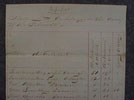
Click to Enlarge |
A well preserved document on a large sheet heavy paper that folds open, listing all of the Ambulances and Spring Wagons
in the various Corps of the Army of the Potomac.
Hey's Saw

Click to Enlarge |
An extra fine condition Hey's saw from Civil war Period. Ebony handle. (Wood could no longer be used once they started using hot "sterilizing" procedures later in Century because it would warp the wood.) This is for elevating the tough envelopes around brain in neurologic surgery. These were found in the larger "Capital Surgical" instrument sets of the Civil War Period. No maker's marks.
Civil War Period Amputation Saw by Leach & Greene

Click to Enlarge |
A lovely amputation saw of the type that was used in most capital operating sets during the Civil WAr. Fine toothed steel blade; brass frame; cross-hatched ebony handle; and marked on the brass, "Leach & Greene". Some scattered rust on blade but very solid and impressive. With no reconstructive bone or vascular capabilities at that time, amputations were the norm due to the massive damage inflicted by the large caliber bullets used in the Civil War period. If battered & decaying tissues were left, infection and deadly gangrene often set in. So, better to save the person than the limb... They say a good surgeon could take off a leg in about a minute!
London-made Wingnut Tourniquet
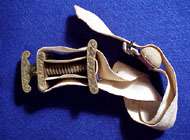
Click to Enlarge |
This item is an extremely high quality brass screw-type of
tourniquet as was often contained in Capital Surgical Sets used in Field Hospitals. The canvas strap was tightened to draw
the wad down upon an artery, thus staunching the flow of blood from a prior wound or from cuts made during surgery. Made by Evans & Co. of London. These are sometimes excavated in battle areas and the field hospital sites to the rear. It is 3 3/4" high. Field orderlies had access to cheaper buckle-type torniquets that quickly strapped a gushing limb dry until the victim was rushed to the rear...
1862 Receipt to accept a Crazy Soldier

Click to Enlarge |
This is a one page receipt from Assistant Surgeon at the Judiciary Square Hospital in Washington, DC, for John Itle, an "Insane Soldier". He was received from escort Lt. A.L.
Couger 125th Reg't Ohio Volunteers on Aug 15th, 1862. With tremendous casualities occuring in huge consecutive battles emotional stress and mental breakdown took its toll as well as injury and disease. Battlefields were often gruesome and soldiers often came across half-decomposed soldiers out in isolated woods. The constant loss of friends and barrage of artillery in one's ears could certainly drive a man insane.
Glass Medical Syringe from 1864 Camp

Click to Enlarge |
A nice hand blown medical syringe from an 1864 army camp site. The glass plunger rod has no string wrapping now(used to make a tight fit and thus, to push along the solution) on end any longer. Injections were not given very much during the Civil War period. Transfusions of blood and I.V. medications were as-yet unheard of!
Surgeon's Folding Pocket Instrument Case
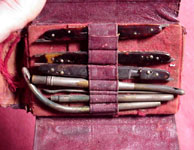
Click to Enlarge |
This is a splendid little brown leather folding case, with a metal snap clasp closure, that measures 5" x 3" when closed. The central compartment has leather loops that hold: 3 tortoise shell handled snap-lock tools including scalpels and spatula-like scrapers (two instrument sides to each piece!), as well as, 3 trocars, and 1 small metal scoop. These instruments are same as shown in Dr. Gordon Dammann's book on Civil War Medical Instruments (pp.27 & 28) The case also has a "wallet" in back!
Steel plate Engraving: Medical College of Georgia 1844
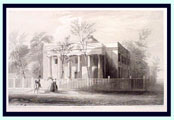
Click to Enlarge |
Nice steel engraving of the Medical College of Georgia in 1844. Obviously many Ga. Surgeons in the War had graduated from there. Image 4 x 6". Nice Condition. Comes unframed.
CIVIL WAR PERIOD BRASS BLEEDER

Click to Enlarge |
This is a Spring-loaded bleeder from the Civil War period. It was probably made in Germany and imported here. It comes in s custom-fitted wooden box lined with pattered cotton. Full 3 1/4" long. One can slide rear panel off to see spring mechanism inside. Used for draining the sick or toxic "humours" from the ill patient's vascular system.
Surgeon from 6th Maryland Regiment

Click to Enlarge |
This is a small collection of items from Dr. Edwin K. Foreman (1837-1906), surgeon to 6th Maryland Inf. Regiment from Sept 15,1862 through June 20th, 1865. He graduated from the University of Maryland School of Medicine in 1862. The 6th Maryland arrived at Gettysburg soon after the battle. Foreman family lore says that Edwin worked at the Spangler farm field hospital for a time. Wounded from the battle were still present for weeks afterward. This collection includes: a major's-rank shoulder board; his red and green aiguilette (shoulder cord); a fancy twelve-blade spring-loaded scarifier with box; an 1880's family photo taken at The Devil's Den; and two 1880's Reunion Fliers for the 6th Maryland, listing Foreman as an attendant. An interesting Medical School course of study pamphlet from 1861 is present. Overall, a wonderful group of war-related items all focused around one man who served both his country and his comrads in the healing arts. His obituary tells us that old Doc Foreman died in his carriage on the way to make a house call in a snowstorm.
Oddly-shaped bone toothbrush handle

Click to Enlarge |
This is an oddly-shaped bone toothbrush handle from CW period. The horse hair bristles are missing as usual with dug toothbrushes. This shows the many interesting variations in shape/design that makers tried in the mid-1800's. Has faint maker's marks impressed at base of the handle. Solid. Site unknown.
Civil War Amputation Knife Set

Click to Enlarge |
Three bright, shiny, razor-sharp blades from Charriere of Paris in a custom-fit wooden case. Such blades were imported from both France and England during the Civil War. They were used to quickly slice through muscle, tendon, fascia and flesh to get to the bone during limb amputations. A very neat and well preserved set. These are the types of instruments that Jack-the-Ripper used in England later in the century...
Ivory and Brass CW Period Stomach/Cavity Pump

Click to Enlarge |
A very interesting set of old Medical equipment, contemporary to the Civil War. A brass hand-pump, connected by a weaved tubing to various custom-made ivory tips. Physicians would use this apparatus to pump out various body cavities. I suppose that most soldiers would rather face deadly double-cannister on the battlefield than to take on one of these nasty babies!!! Contrary to our impressions, doctors were quite well-trained and sophisticated in the 1860's, going to formal Medical Schools in the east to study anatomy, physiology, pharmaceuticals, and natural curatives. They were at a crossroads between the old and new worlds of scientific knowledge. Sadly, modern doctors know nothing of herbalism or the great homeopathic philosophies. Civil War physicians did not simply cut off legs and watch people die. They were excellent hands-on diagnosticians who cared greatly, applied dressings, did minor surgery, made their own medications. They could all set a bone, drain a boil, compose a hysteric and even deliver a baby on a buckboard if need be! This pump-set is an uncommon accessory in its original walnut box. (No, I have NOT tested it!!!)
Entire Inventory of a Union Army Hospital!!!

Click to Enlarge |
This is a year-end inventory report to the U.S.A. Medical Department for all supplies, foods, equipment and medication located in an 1865 Union Army Hospital. This folds open over-and-over again to fourteen large pages in the same way as our modern road maps unfold. Listed in columns are #1) the equipment such as splints, blankets, socks, beds & crutches; #2) the actual foods, such as coffee, chocolate, farina; #3) the medications, of a huge eclectic variety: potassium, strychnine (a poison!), and spiritus fermenti (whiskey) which doctors gave as a sedative, sleep aid, and to prevent DT's in alcoholics. This is signed by the hospital commander who was with the 61st Ohio, and indeed, this telling-archive was recently brought-to-light in Ohio. Other Surgeons assigned to the hospital were from New York and Connecticut. This is an amazing glimpse into the actual functioning of an Army Hospital at the close of the Civil War!!!
AMAZING CIVIL WAR HOSPITAL LEG BRACE

Click to Enlarge |
This is an utterly amazing item, showing the ingenuity and resourcefulness of Civil War period manufacturers: a wooden leg brace by maker "A. Goodwin Ashfield" which incorporates pivots, ratchets and other mechanics which allow exact positioning of an injured lowerlimb. This brace pivots up and down at the knee to adjust flexion and extension of that joint, locking into place by setting the heel position upon the step-cut base. The wood (Walnut or chestnut)has been contoured to comfortably fit the lower thigh and the calf. Then, there is a heel plate that is adjusted by two large wooden turnscrews which raise the foot into dorsi-flexion or lower it into plantar (toe down) flexion. There are remnants of canvas straps at the sides that held the leg solidly in place. These are made of the same type canvas strips of which Civil War field tourniquets were fabricated, being fixed in position by small lock-buckles. The entire assembly is set upon a base of solid wood with a T-shaped end strut for better stabilization in bed. It's a fantastic piece of workmanship meant for those men whose legs could be salvaged rather than amputated.
Water Filter

Click to Enlarge |
As shown in Lord's Civil War Encyclopedia, these are the two metallic parts of a "water filter" sold privately to soldiers. The foul, often brackish waters near large numbers of encamped men often bore highly-deadly diseases like dystentery which lead to intense, chronic diarrhea, dehydration and frequent death. In fact, more men died from disease during the Civil War than battle! Knowing the risks of drinking water, troops were lulled into a sense of false security by purchasing these filter sets in tin cases. The soldier was supposed to place the larger filter end into the stream or pond, drawing water up through a charcoal filter by sucking on the smaller mouthpiece. A mesh tubing connected the two, but has since rotted away while it was still underground. THis was located near Fredericksburg along with two others. It is said that soldiers' eyes bugged out like frogs as they vainly tried to suck water up through these. While the concept was good, it is unfortunate that the microbes culprits were small enough to pass beyond the charcoal!!! Men died in spite of their filters.
Tiemann & Co. Digital Amputation Saw

Click to Enlarge |
This is a very nifty amputation saw by the famous Civil War period maker Tiemann & Co. of New York. It is not for a major longbone like the upper arm or leg near hip, but rather, is intended for separating medium-sized bones like the ulna of the forearm, fibula of the lower leg and digits from the hands and feet. The smooth grip is a warm, medium-toned walnut, set firmly into the steel shaft marked "Tiemann & Co." The finely serated blade has a gentle curve to improve the mechanics of the sawing action.
Civil War Period Crutch

Click to Enlarge |
Crutches during the Civil War were not made with the double body struts like now. They were a long, sturdy pole of hardwood doweled-into a top piece that fit under the armpit. These could be quickly made byu local woodshops or by carpenters escorting the Divisions. This one of either walnut or fine-grained oak was padded over the years with a green (or faded dark brown) heavy cloth that is sewn with heavy brown thread. It keeps the wood from digging into the flesh and irritaing it with constant use... An arm could get numb, sometimes permanently, if pressure on the nerve was constant and intense. Civil War doctors were very wise about such details of care... I have not taken off the cloth-pad, as there is nothing to find under there other than the plain wood top piece. These were rarely maker-marked. It is 50" long.
Civil War Hospital Wooden Lower Leg Splint

Click to Enlarge |
This is a factory molded piece of walnut used by physicians during the Civil War period to splint broken or injured lower legs (tibia-fibula). Soldiers would wear these for weeks or months while healing in larger hospitals in Washington and Philadelphia. Made by various manufacturers, they have a wonderfully smooth & exact construction that suits the natural curve of anatomy to the area where they are intended. These came in different sizes, as did soldiers, so there are 3, 4, 5, etc, getting progressively longer and wider. This is a number 6, as we find marked on its backside along with the manufacturer's marking: DAY, Bennington, VT." Such items were made for wrists and knees too, as can also be seen in our Civil War "Museum" Tour link. The overall condition of this is excellent.
Medical War Keg from Ambulance

Click to Enlarge |
Medical "ambulances" were narrow horse drawn carriages that arrived at a battlefield after the combatants chose to fully retire. They carried supplies and transported those who were more-gravenly wounded. Most real management of the casualties was still done back behind-the-lines at tented field stations and temporary hospitals. However, the medical corpsmen and stewards did stabilize extremities and staunch blood flow to some extent before bringing the injured back in ambulances or on rudimentary stretchers. Each ambulance carried two water kegs. Battles were mostly fought in the more humid South during the spring and summer months, and therefore, bleeding men were often parched from dehydration through blood loss. A simple cup of water was a tremendous act of last mercy to men who were soon to die. These standard-design medical water kegs are made of strong oak staves custom-fitted and held by iron banding-straps. There are always two plugs: one threaded at the top and a turnscrew faucet type at side. Two of the straps were bent into stabilizing "feet" in order to keep the keg upright on a wagon back or the ground. There are no markings on this item, but it is of the same design as shown in Dr. Gordon Dammann's fine book "Civil War Medical Instruments & Equipment" page 81. Length 17 3/4" and height about 11 inches.
1862 Atlantic Monthly: Sanitary Condition of Army

Click to Enlarge |
The October 1862 issue of "The Atlantic Monthly" devotes half its volume to a very detailed report about the health and sanitary conditions of the United States (Union) Army, comparing rates of sickness and death to those of other countries during recent wars as-well-as the varied rates of survivorship in different Union Army Generals' divisions. There is much scientific speculation about cause-and-effect as well as suggestions for improvements which might reduce the horrendously high death rate from water, food and air-borne diseases. In reality, death from disease was higher than death from battle during the American Civil War.
Examination Questions for Army Surgeon Candidates: 1862

Click to Enlarge |
A very neat issue of the "American Medical Times" dated November 15th, 1862 which is full of scholarly medical reports, advertisements for medical books, and offering of equipment, medicines and false limbs. But best are the sample questions typically put to a candidate for the position of Assistant-Surgeon in the U.S. Army. Besides the more typical questions, such as, "Describe the origin, course and distribution of the pneumogastric nerve," are more practical ones like, "what are the best mens of getting rid of excrementitious matters of a camp, of a camp hospital, and of a permanent hospital." But my favorite test of a true doctor is this one: "What means would you employ to distinguish whether the stains on a sword were blood stains or ordinary rust?" (Well, duhh, look and see if anybody nearby has a sword hole in them...)
1862 Nurse's Night Light and Broth Warmer

Click to Enlarge |
This is an excellent example of the Nurse's or Hospital Steward's Night Light which was carried through large hospital wards of convalescing soldiers during the Civil War. The components are made of tin with "tole painted" floral designs on the outer body. A hinged door opens to allow access to a small kerosene lamp with 1862 on knob. This cast off a warm & gentle light to guide attendants through the rows of beds at night. But it also warmed a tin broth cup above it. Thus, these lamps served the dual purpose of giving light and yielding sustenance to the ill. Sadly, many were cast into trash heaps as electricity made them seem old-fashioned and obsolete. This one is in unusually good condition. Just imagine sick and dieing lay pondering their ultimate fate~ Can you picture those caring hushed figures checking on the wounded by that gentle light~ and bringing them their last warm sustenance upon this earth?
Three Bladed Surgeons Fleam

Click to Enlarge |
This is an outstanding CW period 3-blade fleam, used to "let blood" from ailing patients. Before they knew about germs and infections, the theoiry was to let out the bad humours, toxins and poisons in the feverish person's body by draining off specific amounts of blood. THe blade tips were used to lightly cut across superficial veins, usually in the forearms. So, in essence, your doctor came to your house in a buggy, examined you, and then cut your arms with these fleams till he was satisfied you were healthier from the process. Then you were wrapped up and paid him for the service. (Then you either lived or died...) This item has the typical construction and component shapes: a brass outer housing into which fit the pivoting steel blades. Usually there were three, but I have seen two and four-blade varieties as well. This example is beautifully hallmarked by its famous maker: Joseph Rodgers & Sons, No 6 Norfolk St. Sheffield (England)."
Bone Apothocary Spoon

Click to Enlarge |
A finely carved spoon made of animal bone, used for scooping out powdered medications from the larger jars and glass bottles carried in big boxed medical kits. Could have been used by a civilian apothocary as well. Most medications were still hand-mixed on a daily, individual basis in the 1860's according to a strict set of preset formula or a hand-scrawled "perscription" by the physician with notations as to very-exact amounts of each ingredient in grains, ounces or drachims. This is a cool item. It shows our former use of animal bone in a more pastoral society for quite practical items, such as utensils, tool handles, buttons, dice, dominoes, and spacer rings on instruments. Camel and cow bone is still used a lot in China, India, Africa and Middle East. Grips for decorative daggers and canes come from gazelle, zebra and lions in Africa. Horns are used in Middle East and China for daggers, jewelry and actual "herbal" folk medications. Any waste of something useful seems ridiculous to members of these more "earthy" societies. America once employed bone, fur, horn and leather from animals to their fullnest. Now, it is considered not "politically correct." You can see the darker lines or "grain" of the bone's trabeculae (struts of growth) on the bowl & grip of this spoon.
Three-Pieced Supossitory Mold

Click to Enlarge |
This is an interesting heavy brass suppository-making mold from the Civil War Period. The three precision-aligned sections are held tightly-together by a pair of thumb-screws at each end. Civil War doctors often made their own medicated preparations. Today, this task is left to Pharmacists and more-often manufacturing facilities at Drug Companies where uniformity of components is better-assured under quality-control conditions.
Shoulder Boards of Dr. Hosea H. Smith

Click to Enlarge |
These are the Civil War shoulder boards of a Union Major. They belonged to Surgeon Hosea H. Smith who was born to Daniel and Lydia Smith in Meredith, NH in 1832. He enlisted on 8/19/1862 into the 8th NH Infantry as a Surgeon, and was later commissioned into Field & Staff of the LA 1st (Union) Cavalry in August of 1863. He then became Acting Medical Director of Cavalry Forces of the South in June of 1865. After the war he finally moved to Detroit and died on 12/3/1866 at 34 years of age.
Pewter Medical Irrigator tip

Click to Enlarge |
This is a dug pewter syringe-irrigator tip. It has threads where it was screwed into a metal syringe. Water could be used to flush wounds, body cavities, or the andomen during surgery. The end of this has holes for creating a pressurized jet of water. This was dug near Fairfax Station, VA. The site is forever covered by a McDonalds now! What other relics from our past are locked under new homes, parking lots, roads, schools and strip malls? A bullet from same site shows the size of this irrigator tip. It is 4 1/8 inches long.
Huge Pewter Irrigator Syringe

Click to Enlarge |
This is an extremely large irrigatory made out of pewter and marked on the rim "HD/US" meaning "Hospital Department/ United States." Internal leather plunfers seal off the inner cavity so that liquids and gels could be forced out tip by raming down on the wooden plunger. This was used for larger body cavities and could even have been employed in the Veternary Care of the Cavalry's horses (hopefully not on two species in the same day!)... Without an effective use of electricity yet during the American Civil War, equipment was literally hand-driven with elbow-grease. Thus, both suction effects and washing procedures were done with such pieces of equipment. Imagine a wounded or sick soldier's dread when seeing the physician carrying such a big metal human plunger toward you! Some might claim that staying sick was the better option!
Pontil Medicine Bottle

Click to Enlarge |
This is a privy dug Civil War period light aqua medical bottle with applied upper lip and a pontil scar on base. 4 1/4" high
Hospital Steward Photograph

Click to Enlarge |
This is an original Civil War CDV photograph of an identified soldier. Soldier is identified as Thomas H. Leslie, Hos. Steward (Hospital Steward), 1st Alabama Infantry Volunteers. Soldier displays medical armband with the intertwined snakes "cadeuces" symbol. It appears that he also holds a sword behind his leg.
The 1st Alabama Regiment Infantry (African descent) was an Infantry Regiment recruited from African Americans that served in the Union Army during the Civil War. The 1st Regiment was raised at Corinth, Mississippi May 21, 1863 after Federal Troops occupied the area. The regiment was redesignated the 55th U.S. Regiment of Colored Troops on March 11, 1864.
Such nice images of hospital stewards are uncommon.
Bullet or Foreign Body Extractor

Click to Enlarge |
This type of forcep instrument has wide serrated cups on the ends in order to grab bullets or foreign bodies out from wounds. Imagine a field surgeon in a bloody butcher's smock without gloves digging "by feel" around inside your arm or leg! This is a smaller version at 4 1/4 inches long. It is maker-marked "Lentz".
Tin Instrument sterilizer lamp

Click to Enlarge |
This is a cool instrument sterilizer. It has a cap that opens to a double-wick kerosene burner over the font chamber. There are two raised tin brackets or "rests" for placing handles of instruments. The tips then sat in the flame to get sterilized. (They probably wiped the soot off on their pants before using them!) Most likey for scalpels or small probes. No maker's markings. A neat medical item for your Surgeon's tent. About 4 3/4" long.
1861 Bowdoin College Medical School lecture ticket

Click to Enlarge |
This is an original 1861 admission ticket for a Lecture at Medical School of Maine at Bowdoin College on Obstetrics and Diseases of Women and Children. This is the college where Joshua Chamberlain was a Professor of Theology just prior to Civil War. Maybe he was interested in women & children, and attended??? Nice condition. About 4 1/4 by 3" on white cardstock. Admits Mr: E.J. O'Donnell.
Fancy Porcelain Hospital Bed Marker

Click to Enlarge |
This is an original porcelain bed marker of the type used to mark beds in Civil War hospital wards so that they knew who they were treating (or burying) that day. It's in great shape. About 3" high. Bed Number was 39.
Early 20-th Century Amputation Kit

Click to Enlarge |
The later amputation field kits were much the same as those used during Civil War except that handles were metal now that heat-sterilization came into being. Old wood handles warped! This set in a lovely maple box has bullet forceps, a skull trephine, and bone saw, among other items. It dates to 1895-1915 era.
Pain bullet from Confederate trench

Click to Enlarge |
Pain bullets were lead slugs that were bitten down upon by suffering wounded soldiers in anguish after battles during the Civil War. When very little pain medication existed for thousands of troopers who languished with mortal wounds, gnashing on a semi-soft lead bullet focused their pain elsewhere. Often you were placed in a pup tent outside, or on a small cot, or a convenient local church pew and left to simply live or die. You chewed while you waited to discover which was your fate... The marks of molar teeth can be seen impressed deeply down into this bullet. It is a Confederate Gardner which was recovered in a Confederate trench.
Large Albumin of Civil War Medical Team

Click to Enlarge |
This is a large framed albumin photograph of a Civil War medical team. At the center is a very intense major with cool modified oak leaves on his jacket. He has a pinky ring, watch chain, and crucifix cravat pin. Looks stressed, like he's cut off too many legs and emptied too many brandy bottles. Two Lieutenants are beside him as well as two attendents. The standing hospital steward wears a Medical arm band with a cadeuses snake-staff motif. There are no ID's yet known, but this is a team that likely worked endless hours together to save wounded and sick Civil War troopers.
Rare Civil War Hospital Steward Caduceus Chevrons
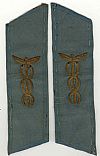
Click to Enlarge |
This shows an original pair of very rare Union Hospital Stewards cloth chevron bands. They have hand stitched snake and staff of the medical profession since Greek times called the caduceus, still a symbol of physicians today. The edging is missing but cloth field and caduceus device are in superb condition. Such chevrons can be seen on photographic examples of Hospital Stewards' typical dress uniforms from Civil War reference books.
Original Tin for Quinine Pills from USA Medical Purveyor
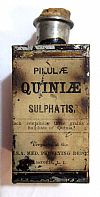
Click to Enlarge |
This is a very rare 3 5/8" tall tin for pills of Sulphate of Quinine. Used extensively during Civil War to treat malaria, which was still prevalent in parts of the USA. Quinine was major medication more malaria until early 1900's. Pilulae means pills. A few are still shaking around in the bottom of this tin! This medication was supplied by "USA Medical Purveying Depot in Astoria, Long Island. The majority of these medical tins were sent to trash pits, or lost their paper labels over the years. Similar tins are held in museums of the Civil War.
Violet Glass Corded Medical Syringe

Click to Enlarge |
This is an early two piece syringe. It is a light violet glass to both body and plunger. The cording wrapped on end of plunger to push medication is in great shape. No makers markings. No needle.
Large Box of Civil War Medical Splints and Braces

Click to Enlarge |
Large sets of wooden splints and braces were sold by suppliers to doctors during the Civil War. They were smooth, shaped wood to fit wrists, ankles, elbows which were then held on with wraps of bandage. This is one such boxed set that was recently found stored intact. You can see the large folding leg (hip,knee, ankle) brace. Sadly, these sets have mostly been broken up and sold off piecemeal. So, an intact set is rare, but costly. Many of these are still marked by their Vermont manufacturer. At least the slick, varnished wood could be washed off between patients!
1942 US Army Medical Department Stretcher
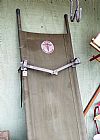
Click to Enlarge |
Walking out of a small Antiques Co-Op, what did I spy??? (No way!) An original 1942 US Army Medical Department stretcher for wounded soldiers. Sturdy woven canvas cradle held about 8 inches off ground by a pivoting iron framework which can swing open or closed for storage! It is actually marked by manufacturer: "Superior Sleeprite Corp/ Aug 1942" on the frame. It is 88 inches long. Lifted on either side by green wooden grips tightly attached to heavy rods which slide through the cuff at canvas sides. This is the real deal. Technically, it could have been at all the major US Army Battles in either Europe or the Pacific. How many of these are left in such great shape???
Fancy Brass Multiple Blade Scarifier
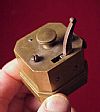
Click to Enlarge |
This is a fancy brass multi-blade scarifier or "bleeder" used in the early to mid 1800s to cause thin superficial cuts in order "to bleed" a patient of the evil humours in the sick body. Fell out of practice mid 1800s. This has multiple fine blades that appear out the slits in the base when trigger is pulled. That way, the device cuts the patient, not the barber or doctor! NFS
Tole tin kerosene Nurse's Broth Warming Lamp

Click to Enlarge |
This is a very nice tin kerosene lamp which warms a cup of broth on top for the sick or injured. Used by nurses and orderlies as it also casts some soft light through it's perforations in the body. Two handles, kerosene lamp and lidded cup all intact. Once has some tole painting on body which can barely be seen now. No markings. About 9 inches tall.
|

